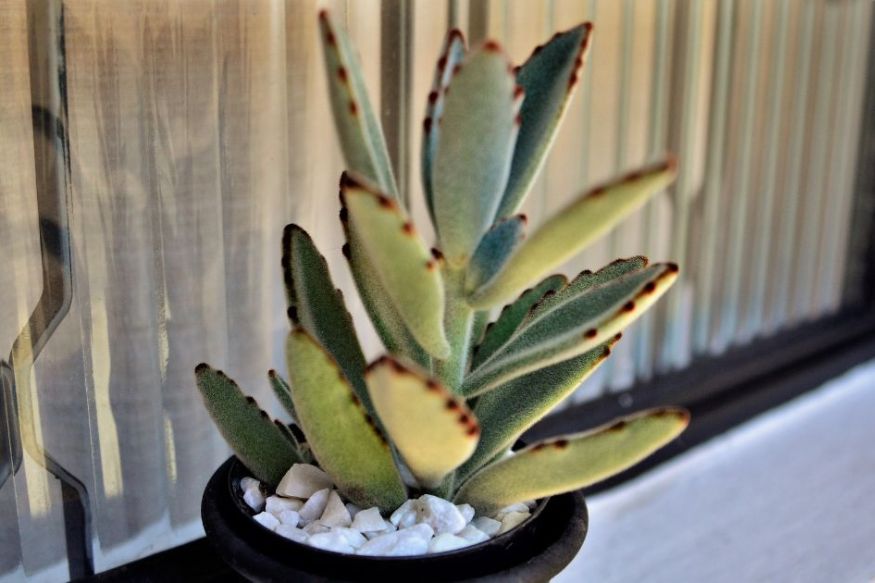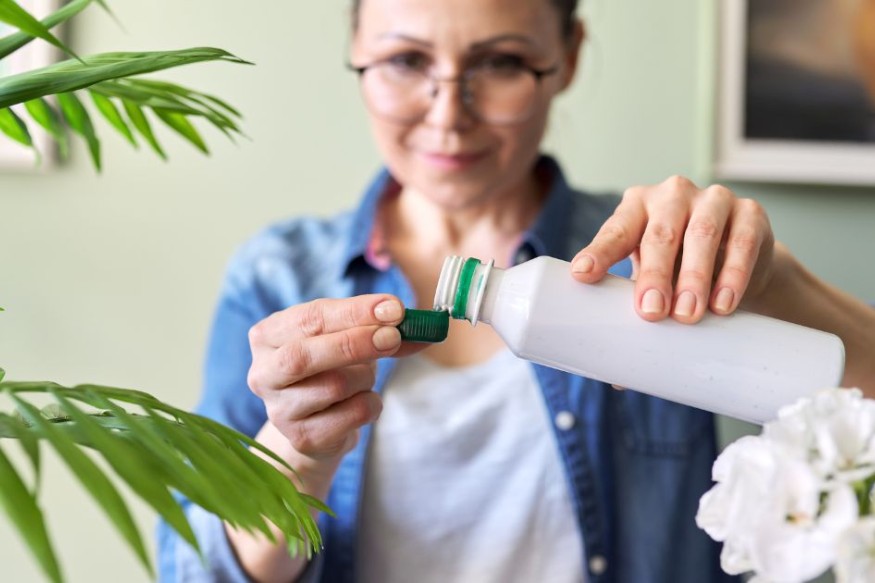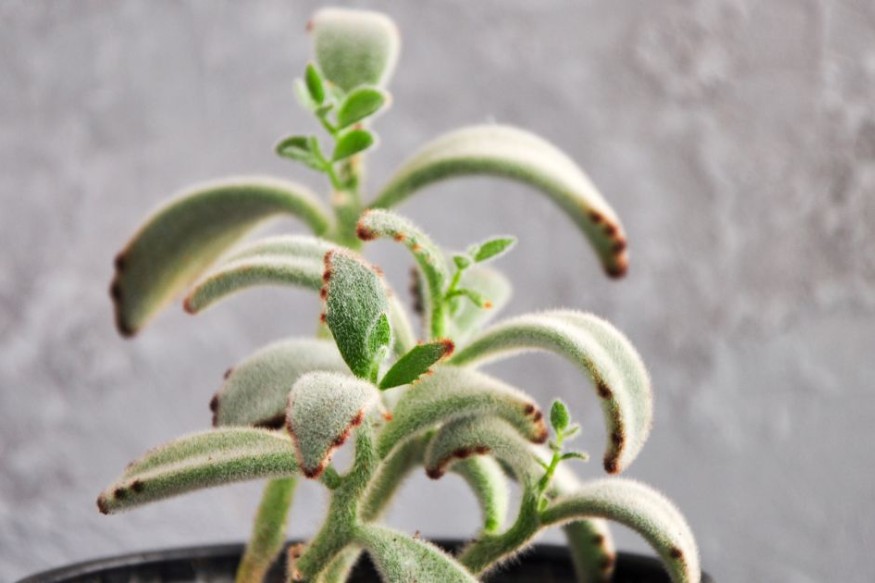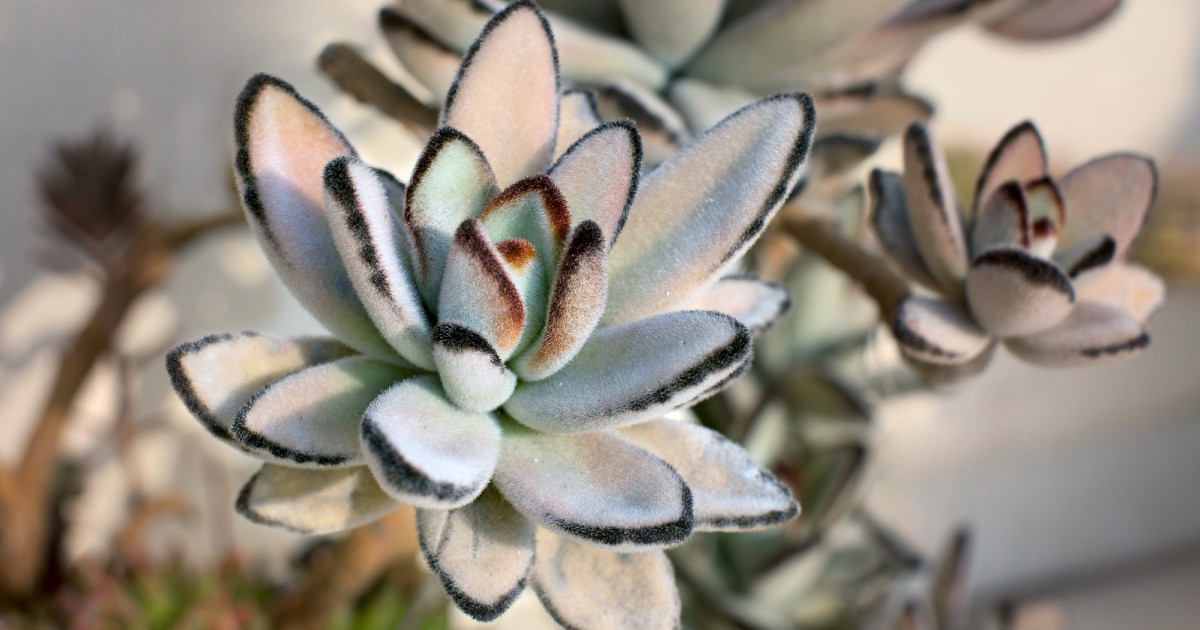It isn’t as strange as it seems that the panda plant—a bushy perennial succulent from Madagascar—is named after an animal from China. Kalanchoe tomentosa got its nickname from its chubby paw-shaped leaves, which are covered in a light velvety fur, and studded along the edge with reddish brown claws.
Unlike pandas, panda plants can be grown anywhere from Madagascar to Michigan, with very minimal maintenance.
Quick Guide to Panda Plant
| Botanical name (Family) | Kalanchoe tomentosa (Crassulaceae family) |
| Sun requirements | Full direct sunlight, as much as possible |
| Hardiness/Zone | Hardy outdoors only in Zones 9+ |
| Water needs | Low water needs; drought-tolerant |
| Toxicity | Mildly toxic to human and pets |
| Primary growth season | Spring and fall; plant may have a summer and/or winter dormancy |
| Typical sizes | A mature shrub outdoors can nearly two feet tall; indoors they typically stay smaller |
Growing Requirements for Panda Plant
Where to Plant Kalanchoe tomentosa
Outdoor Placement

Like a lazy panda, your panda plant wants to eat and drink a little bit, but mainly wants to sunbathe all day, every day. At least six hours will suffice, but the more, the better because a little sun-stress will encourage an attractive red, brown, or black edge along the pokey tips of your panda plant’s leaves. A light-starved panda plant will become leggy.
Don’t plant Kalanchoe directly into the ground unless you are in Zone 9 or higher, and protect it from cold as needed. This plant grows well in a pot as long as it is given suitable soil. That means you can bring it into your house during the winter, but move it outdoors in the summer to soak up as much direct sunlight as possible to encourage the reddish tips.
Outdoors, mature panda plants can produce flowers.
Indoor Placement

If you are relying entirely on natural light, indoor Kalanchoe tomentosa prefer a south-facing window. You can grow them in a window without direct southern exposure, but they are likely to become leggy.
You can always add supplemental light if you don’t have a suitable window. A grow light will keep your panda plant as compact and healthy as possible and encourage the red tips to develop.
Pet Access
Kalanchoes are mildly poisonous for pets and small children. However, they don’t unexpectedly drop as many leaves as other succulents. It also doesn’t look as appealing to many potential snackers, so it is not as dangerous as some toxic succulents if grown responsibly. However, if you’d prefer not to have to worry about it, check out our guide to pet-safe succulents.
Container and Soil Tips For The Panda Plant

You wouldn’t expect a panda to live in a lake, and you shouldn’t expect your panda plant to live in one, either.
Succulents are generally easy to maintain, but none will tolerate a pot full of soggy soil. With inadequate drainage or potting mix unsuitable for succulents, your panda plant will develop root rot, among other potential problems.
A pot with a good-sized drainage hole is the best foundation for a healthy panda plant. If you want to use a pot that doesn’t have a drainage hole, check out our guide to succulent pots. It includes several strategies for creating good drainage when using a pot with no hole.
Using the right potting mix is another important way to help your panda plant thrive.
Avoid ordinary potting soil in favor of a well-draining succulent or cactus mix that includes lots of perlite or pumice. Some commercial mixes will work in a pinch, but most are peat-based, which is environmentally unsustainable and has disadvantages.
We recommend making your own, using our DIY succulent potting mix recipe.
With just four inexpensive and readily available ingredients, you can make a potting mix that is environmentally safe and ideally suited to your panda plant’s drainage, nutrition, and pH needs. It is also cheaper than buying commercially produced cactus or succulent potting mixes.
Watering the Kalanchoe tomentosa
Most succulents do not require watering as frequently as typical houseplants. They come from arid and semi-arid environments, where they grow in soil with little organic matter to absorb the occasional downpour. They evolved thick, fleshy leaves to store lots of water between infrequent storms. The panda plant is no exception.
We recommend the classic “soak and dry” method for succulents:
- You give the plant plenty of water
- Let the pot drain fully.
- Leave it alone until the potting mix has dried out (at least a couple of inches deep) before watering again.
For a more detailed explanation of the soak and dry method and other watering techniques, check out our complete guide to watering succulents. It includes a useful tracking card to record your watering, fertilizing and other succulent care.
If you’re forgetful and don’t want to use the card, no worries. All you have to do is look at your plant from time to time. Panda plant leaves should be thick and firm. If they begin looking and feeling soft and limp, they’re depleting their reserves and need to be watered.
Kalanchoe tomentosa Fertilizer and Maintenance

The best policy is to repot all newly purchased succulents, and again every few years after that. That allows you to check if the roots are healthy and if the plant is potted at the right depth.
Replacing the soil also reduces the likelihood of bringing in soil-borne diseases or pests (but we still recommend quarantine for any new plant until you’re sure it is bug-free). You should also cut away any unhealthy roots before replanting.
Repotting your new plant also means making sure it is growing in a fresh, well-draining potting mix suitable for succulents.
Note: When you do repot, you do not need to fertilize your panda plant for the first year. It will get plenty of nutrients from the fresh potting mix.
In subsequent years, fertilize your panda plant occasionally with an organic, liquid, cactus- or succulent-specific fertilizer. My go-to is Dr. Earth Organic & Natural Pump & Grow Succulence Cactus & Succulent Plant Food. Follow the package instructions for that or any other organic, succulent-specific fertilizer.
If you are using a chemical fertilizer not designed for succulents, make sure to dilute it to a quarter-strength, or at most half-strength, rather than the concentration recommended on the package.
Note: Avoid any fertilizer with an NPK ratio highest in nitrogen (N). An even balance is preferable.
Succulents are slow-growing plants, and if you add more fertilizer than your panda plant can absorb from the soil, the excess nutrients can burn its roots. Fertilizing a few times per year is sufficient, and avoid fertilizing when the plant is dormant.
Propagation of the Panda Plant

Kalanchoe tomentosa can be propagated using leaf or stem cuttings (or grown from seed), but stem cuttings are more likely to take root. Always use a sterile, sharp blade or shears to take the cutting. This will help you avoid bruising the stem or spreading disease.
If you’re using a stem cutting, strip or cut off a couple of the bottommost leaves from the stem. Make sure the separation is flat and the stem is not cratered because inside that connection point is meristem tissue that will help the stem grow roots.
You should also remove these leaves from the bottom (root-end) of the cutting. It will not grow if planted upside down.
Before planting your cutting, allow the stem to cure (dry out) for a couple of days. It will form a callus over the raw area. During this curing period, keep the plant out of direct sunlight.
Once it is cured, simply stick the root-end directly into a pot of moist, well-draining succulent potting mix. Ideally, we recommend using our recipe for Seed Starting/Propagation Mix, but any of our recipes will work in a pinch.
Gradually move the propagated plant back to full sunlight. You shouldn’t need to water the cutting much for the first couple of weeks. It’s okay if the layer of potting mix becomes dry.
The leaves contain plenty of water and nutrients to sustain the new plant as its roots, and allowing the top of the soil to dry encourages the new roots to stretch for water.
Common Panda Plant Problems
Panda plants don’t have any particularly unusual problems. Like most succulents, they can fall victim to mealybugs or aphids. For tips on dealing with mealybugs and other pests, check out our guide to getting rid of mealybugs.
Some other common problems and their solutions are listed below.
Leggy Panda Plant
If you notice your Panda Plant looking a bit stretched out and scraggly, that’s what we call “leggy,” and it happens when your plant isn’t getting enough sunlight.
Treatment
- Use a Grow Light: For an indoor Kalanchoe tomentosa, a grow light can help your lanky plant regain its original charming look.
- Understand the Limitations: Once a succulent gets leggy, only the top part will grow back strong and compact, potentially making it top-heavy and prone to falling over.
- Propagate the Plant: The best way to deal with an overly leggy Panda Plant is propagation.
- Snip Off Leaves or Stem Cuttings: Use clean scissors to cut some leaves or stem cuttings.
- Let Them Dry: Allow the cuttings to dry out for a bit until a callus forms over the cut area.
- Plant the Cuttings: Plant the dried cuttings in a well-draining succulent mix.
- Resume Normal Care: Follow the usual succulent care routine for these baby plants.
- Sunlight: Ensure they get plenty of light.
- Watering: Use the soak-and-dry method to water them properly.
Powdery Mildew
Has your Panda Plant started to look like it’s been dusted with powdered sugar? That’s powdery mildew making itself at home. This pesky fungus appears as a white or gray powdery substance on the leaves and needs to be evicted ASAP.
Treatment:
- Remove Infected Leaves: Grab some clean scissors and prune away those mildewed leaves. Think of it as giving your Panda Plant a much-needed haircut.
- Improve Air Circulation: A stuffy room is a breeding ground for mildew. Place your plant in a well-ventilated area or even use a fan to get the air moving.
- Reduce Humidity: Overwatering is a big no-no. Ensure proper drainage and consider a dehumidifier if your place is particularly humid.
- Fungicidal Treatment: Apply a fungicide specifically designed for powdery mildew, following the product’s instructions. It’s like giving your plant a protective shield.
- Home Remedies: For a DIY approach, try a baking soda solution (1 teaspoon in 1 quart of water) or a milk spray. Both are surprisingly effective and safe for your plant.
Rust
If you spot small, orange, yellow, or brown pustules on the undersides of your Panda Plant’s leaves, you’ve got a case of rust. This sneaky disease can spread quickly, so early detection is key.
Treatment
- Isolate the Plant: Keep the infected plant away from its leafy friends to prevent the spread of rust.
- Remove Affected Areas: Prune away the infected parts. Your plant will thank you for this tough love.
- Fungicide Application: Use a fungicide formulated specifically for rust. Follow the directions on the label for best results.
- Improve Plant Health: Ensure your plant is getting enough light and nutrients to boost its natural immunity. A healthy plant is a happy plant!
.


